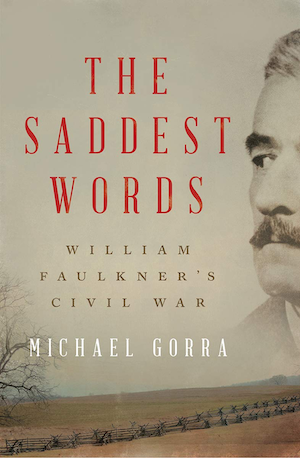By Allen D. Boyer
“This also has been one of the dark places of the earth.” That line from Heart of Darkness appears nowhere in Michael Gorra’s fine book on William Faulkner, and yet it hangs over the text like an epigraph, haunting Faulkner’s fictional county of Yoknapatawpha.
William Faulkner drew deeply on Joseph Conrad, and, like Conrad’s books, Faulkner’s stories wind through characters’ memories into a past of violence. “The Saddest Words”: William Faulkner’s Civil War begins in sunlight, in the stillness of the military park at Gettysburg—where the Confederate brigades are eternally in position behind the rail fence, as Faulkner wrote, and the past isn’t even past. From there, Gorra looks back through Faulkner’s books to the conflagrations of Southern history.
Part of this book deals with the War Between the States, as Faulkner portrayed it. Gorra maps out how Colonel John Sartoris battles the Yankees on the battlefield and abolitionists at the polls, while Bayard Sartoris avenges his murdered grandmother. Those episodes come from Sartoris and The Unvanquished; others emerge from Light In August and Faulkner’s short stories. Gorra spends more time on Absalom, Absalom!, in which young soldiers Henry Sutpen and Charles Bon follow the Confederate banner across the Deep South, then journey home to a fatal encounter.
But, as Gorra recognizes, Absalom, Absalom! builds on the challenge to “tell about the South.” This begins a conversation that ends in the silent outcry, “I don’t hate it! I don’t hate it!” In a rare piece of journalism, Faulkner would describe a novelist who loved his native state “even while hating some of it.” Faulkner’s civil wars, Gorra suggests, included a further conflict: “the civil war within Faulkner himself, his own struggling attempt to come to terms with the war’s meaning; which is to say, with slavery. His attempt—and ours.”
William Faulkner was no public intellectual. At a conference that featured Agrarian writers Allen Tate and Donald Davidson, with whom he might have made common cause, Faulkner spent his time drinking. He shunned politics and did badly when he ventured into controversy. In January 1931, he published a short story that condemned lynching; in February 1931, he wrote an odd, shapeless letter to the editor that made the case for lynching, arguing that Southern vigilantes, “like our juries . . . have a way of being right.” “That vicious letter,” Gorra concludes, shows “how very far Faulkner needed to come—how hard he had to fight with himself—before he could write Absalom, Absalom! and Go Down, Moses.”
The Jim Crow South ruthlessly kept black people down. Just as intensely, the white community kept tabs on its own. The garrison mentality went with the color bar. If you questioned white supremacy, or merely seemed to question white supremacy, this brought probing, suspicious, hostile stares. In Faulkner’s hometown, plenty of people already thought he was a pretentious failure—the “Count No ’Count” nickname stuck. For the novelist, saying nothing about racial injustice, except when he could say it in his fiction, was an obvious response. Faulkner hated talking about his life or work. Racism became one more personal matter on which he could keep silent.
And yet: in the same years that Faulkner was writing Absalom, Absalom, W.E.B. DuBois was attacking the old-school cartoon of Reconstruction government as a benighted carnival of ignorance and corruption. While Faulkner was writing Go Down, Moses, imagining the ledger entries which tell the history of the McCaslin family, he was reading a classic volume of history, The Southern Plantation Overseer by John Spencer Bassett, which collects the correspondence of the overseers on the Mississippi plantations owned by James K. Polk. The tangle of bloodlines and inheritance in the novel and the story collection reflects the same slow process by which the American republic changed its mind about Jim Crow. Just as the nation would move to end segregation and enforce civil rights, Faulkner’s fiction would ultimately condemn racial injustice. And it remains Faulkner’s fiction that lives after him.
For a Massachusetts writer, Gorra’s knowledge of the Civil War and its literature is uncommonly deep. He should look more closely at Gone with the Wind (a novel as sharp-edged as Steinbeck, much less about race and the Old South than about hard times and hard choices), but his glance at The Bostonians is swift and perceptive. In Henry James’ book, a Confederate veteran ventures north to Harvard University’s Memorial Hall, the “buttressed, turreted, cloistered” citadel of a culture that has crushed his own.
Gorra finds in James a vision that counterpoints Faulkner’s perspective: “Each novelist recognized one big thing. They saw that each of [their] states provided an emblem for its section as a whole, that they stood at the most extreme version of a regional consciousness: one the heart of Yankeedom, of abolition and Union, and the other the South of the South.” But that is not the end of it. Where common humanity can be recognized, Memorial Hall can become a place where “the whole question of sides and parties” is forgotten.
This is a serious book, but never a dark study. It is partly a travelogue, partly a loose biography, always a scholar’s careful connection of fiction and history. There is much in it of Joseph Conrad’s method, a slow, meditative layering of different voices. It is a book that ranges broadly but always drives home its point.
Allen D. Boyer (ΦBK, Vanderbilt University, 1977), a native of Oxford, Mississippi, works and writes on Staten Island, a vantage point from which he sometimes ponders the career arc of Basil Ransom. Vanderbilt University is home to the Alpha of Tennessee Chapter of Phi Beta Kappa.




